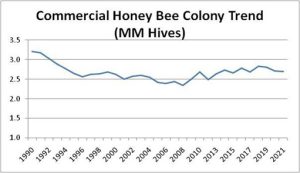Honey Bees Are Not “In Decline”, But The Beekeeping Industry Does Face Challenges
Contributor
I write about issues and technologies related to agriculture and food.

Bee hives in an Almond orchard RANDY OLIVER, SCIENTIFICBEEKEEPING.COM
There is a common phrase that appears in the popular press, in grant proposals and as a fund raising theme for several environmental groups: “the decline of the honey bee.” This is often referenced as a looming threat to the future of our food supply and typically blamed on pesticides. In fact honey bees in the US are doing quite well in terms of hive numbers and availability to pollinate crops. The same is true in other regions.
The field signs of the mysterious “Colony Collapse Disorder” that was of great concern during the 2004-2009 time frame is now seldom seen, with the term now being improperly applied to the well-understood collapse of colonies from the varroa/virus complex. There is an excellent article published in 2020 which debunks the gloom and doom assertions and also the simplistic explanation that the problem is driven by the use of certain insecticides.
The truth is that the the number of colonies of bees are certainly not declining and have actually been increasing in recent years (see graph).

Ever since 2008 there has been a positive trend for bees in terms of the number of commercial hives GRAPH BY AUTHOR BASED ON USDA NASS SURVEY DATA
Although the industry is doing reasonably well, as with other agricultural enterprises, the beekeeping industry still has to deal with important issues. The bees and the related businesses will be best served by a rational assessment of the challenges and efforts focused on solving them. This article is based on interviews with bee expert Randy Oliver who runs the ScientificBeekeeping.com website, publishes extensively in scientific and industry bee journals, and is a sought-after speaker internationally on bee related topics. From Oliver’s perspective the key challenges fall into three main categories:
- Giving beekeepers the tools they need to deal with the parasites and diseasesthat affect bee health
- Having adequate “forage resources” or other feeding options to meet the full-season nutritional needsof the large hive numbers required for the pollination market, and
- Anticipating the future impact of climate changeand the management of agricultural lands on pollinators, and the business of beekeeping.
To access the complete article, go to:
Honeybees Are Not “In Decline”, But The Beekeeping Industry Does Face Challenges (forbes.com)
We are here to share current happenings in the bee industry. Bee Culture gathers and shares articles published by outside sources. For more information about this specific article, please visit the original publish source: Honeybees Are Not “In Decline”, But The Beekeeping Industry Does Face Challenges (forbes.com)








